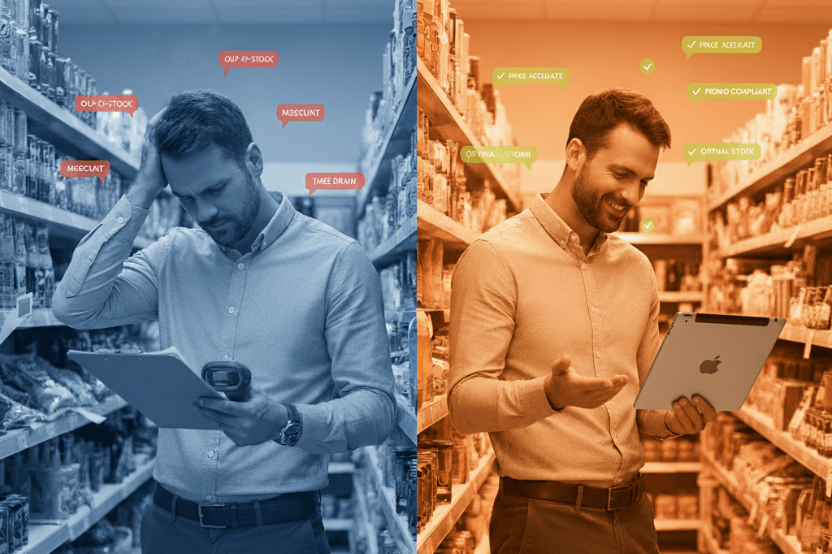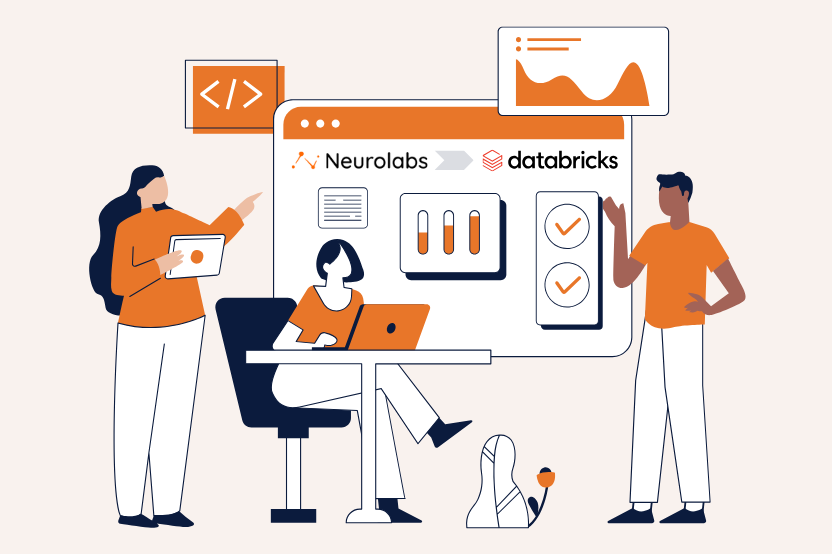Owning a field force is one of the largest costs on any CPG’s balance sheet. Every day, thousands of sales reps visit stores to sell and support retail execution, capturing data, checking compliance and adjusting promotional displays along the way. These activities are crucial, yet they’re also costly, especially in markets where labour costs are high and employment regulations limit flexibility.
In some regions, this makes field operations both more expensive and less flexible, which means every in-store minute has to count. That reality reinforces the growing need for efficiency and automation through Image Recognition.
Too often, sales teams are laser-focused on simply getting visits done. Fixing shelves, measuring compliance or capturing photos can feel like “low-value” admin work. And when KPIs or bonuses depend on self-reported data, inconsistencies and inaccuracies inevitably creep in.
Field teams are hired to sell and optimise, not to spend hours counting packs, logging prices and filling forms. But without automation, that’s exactly where much of their time goes. The outcome? Fewer productive visits, slower fixes and decisions made on partial or incomplete data.
That’s where Image Recognition changes the game. By automating shelf capture and surfacing Next Best Actions during the visit, IR helps reps spend less time collecting data and more time selling, improving in-store productivity in some cases by up to 50%.
The Real Cost of Manual Execution (and the KPIs That Suffer)
When retail execution relies on manual data capture, it creates a cascade of inefficiencies:
- Time drain in-store → Manual tasks in-store drain valuable time, meaning reps complete fewer visits, cover fewer stores and fall behind on planned calls.
- Inconsistent reporting → KPIs like Perfect Store, promo compliance or pricing accuracy become unreliable.
- Slow issue resolution → out-of-stocks and display gaps linger, eroding sales and brand equity.
- Coaching blind spots → leaders lack visibility into rep performance, making ROI harder to prove.
The shift with IR is immediate and measurable. Field teams using image-based automation often achieve one to two extra visits per day, stronger compliance and faster corrective actions, all driving direct uplifts in sell-through and trade ROI.
Quick Wins with IR: Results You Can See in Weeks
One of IR’s biggest advantages is its speed to impact. It fits easily into existing tech stacks, so there’s no downtime, no heavy lift and no risk with results start showing in weeks, not months.
- Automated in-store insights: Eliminate manual counting and photo admin. Standardise SKU, pricing and display data across every visit.
- Improved data accuracy & completeness: Image-verified data provides a single source of truth, powering accurate KPIs, reducing disputes and giving managers reliable insights for coaching and performance improvement.
- Store-level compliance alerts: Detect price errors, missing displays or out-of-stocks all while the rep is still in the aisle.
- Performance benchmarking & coaching: Benchmark reps on objective metrics like visit completion, fix rates and value-at-risk resolved and guide their development using real performance data, not self-reported forms.
Working with a multi-country snacks and confectionary manufacturer, we helped streamline audit speed and quality control across several markets.
The impact was immediate:
- 40% faster audits, enabling more reliable and timely retail execution.
- 95% product recognition accuracy (compared to 91% through manual checks).
- 32% reduction in total quality control costs.
Transformational Impact: Building Long-Term ROI with IR
Once IR becomes part of daily operations, its benefits compound. What begins as data automation evolves into strategic optimisation.
- Next Best Action to maximise ROI per visit: Focus on what matters most. Fill high-velocity out-of-stocks, correct promo pricing and prioritise contracted displays.
- Territory planning & visit prioritisation: Plan visits based on opportunity and risk, not routine. With IR insights, teams can target stores where the biggest sales potential or compliance risks exist, ensuring representative coverage across regions and channels and making every visit count.
- Dynamic re-routing & cross-team coordination: Trigger follow-ups for merchandising teams or store staff when persistent gaps appear and avoid duplicated effort across outsourced and in-house teams.
- Execution-quality → commercial linkage: Connect field activity directly to sell-through data, enabling incentive plans that reward impact, not just activity.
Working with AG Barr, one of the UK’s most iconic drinks manufacturers, we helped automate shelf capture across their field operations.
As a result, the team reduced audit and admin time by 50% per visit. With 96% data accuracy across more than 300 SKUs, field reps gained two additional visits per day and managers finally had consistent, region-wide visibility into execution quality.
What to Measure (A Simple Scorecard)
Commercial leaders must align their field force around a metric framework that links activity to direct revenue impact. A robust field force optimisation aligns around four key pillars:
Tracking these metrics ensures every rep, visit and fix contributes directly to commercial outcomes.
Curious what your team’s uplift could look like? Use our Free Image Recognition ROI Calculator to estimate time savings, additional visits and revenue impact based on your own data.
Driving Adoption: How to Bring Field Teams Along on the IR Journey
The technology is powerful, but lasting impact depends on how well it’s embraced by field teams. Even the most advanced IR solution delivers its full value only when reps clearly see the benefits in their day-to-day work.
At Neurolabs, our work with CPGs shows three clear maturity stages:
- Early adoption: Reps capture images but receive no feedback. Trust erodes and adoption stalls.
- Mid-level maturity: Feedback exists, but without incentives or reinforcement, usage remains patchy.
- Advanced maturity: IR is tied to business outcomes, used to validate execution standards and linked to variable pay. Reps now see IR as a sales enabler, not a compliance tool.
The lesson? People-first transformation wins. Field teams who understand and benefit from IR insights become champions of continuous improvement, not reluctant users.
Why It Matters: Freeing People to Sell and Perform
Field force optimisation isn’t about replacing people, it’s about freeing them to sell.
With IR, CPGs unlock three strategic advantages:
- Revenue growth: More visits, higher compliance and better on-shelf execution.
- Cost optimisation: Less wasted travel and admin leading to smarter territory coverage.
- Trust & engagement: Objective, image-backed metrics that build confidence in performance and incentives.
And perhaps most importantly, happier, more empowered field reps.
The Bottom Line
Manual retail execution is yesterday’s game. Image Recognition brings the visibility, accuracy and speed that modern field teams need to thrive, transforming them from data collectors into sales drivers.
The CPGs who act now will define the next era of field excellence: one where every visit counts, every shelf tells the truth and every rep drives measurable value.
Don’t just take our word for it, see your potential impact. Try the Image Recognition ROI Calculator and discover how much cost and revenue lift is possible in your field operations.
Next in the Series
This article is part of our ongoing series exploring the Four Strategic Levers of Retail Execution in 2025.
If you missed the first instalment, start with From Compliance to Growth: Why Smarter Audits Drive Retail Execution, where I unpacked how intelligent audit automation drives visibility and speed across the shelf.
In this second piece, we’ve focused on Field Force Optimisation, turning data collectors into sales drivers through the power of Image Recognition.
Next, I’ll explore Inventory Optimisation and how connecting shelf visibility to supply chain systems can finally close the loop between what’s planned, shipped and sold.
– Remus Pop, CRO & Co-Founder, Neurolabs
Take the Next Step
- Explore the foundation: The Need for Integrated Visual AI in the CPG Space
- Follow our series on the Four Strategic Levers of Retail Execution, next up: Inventory Optimisation. Stay ahead of the conversation by following Remus Pop and Neurolabs on LinkedIn for the latest insights, use cases and updates in retail execution.
- Ready to see Image Recognition in action? Book a demo with Neurolabs and discover how to unify your retail execution stack.




